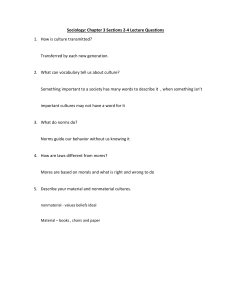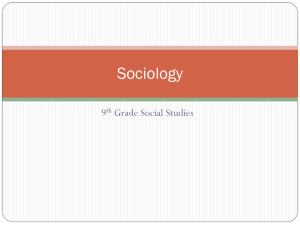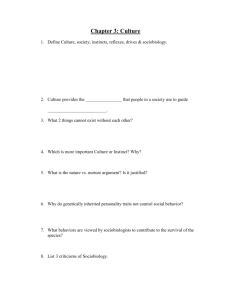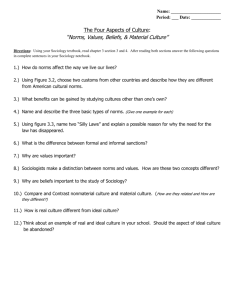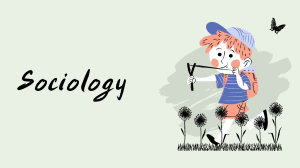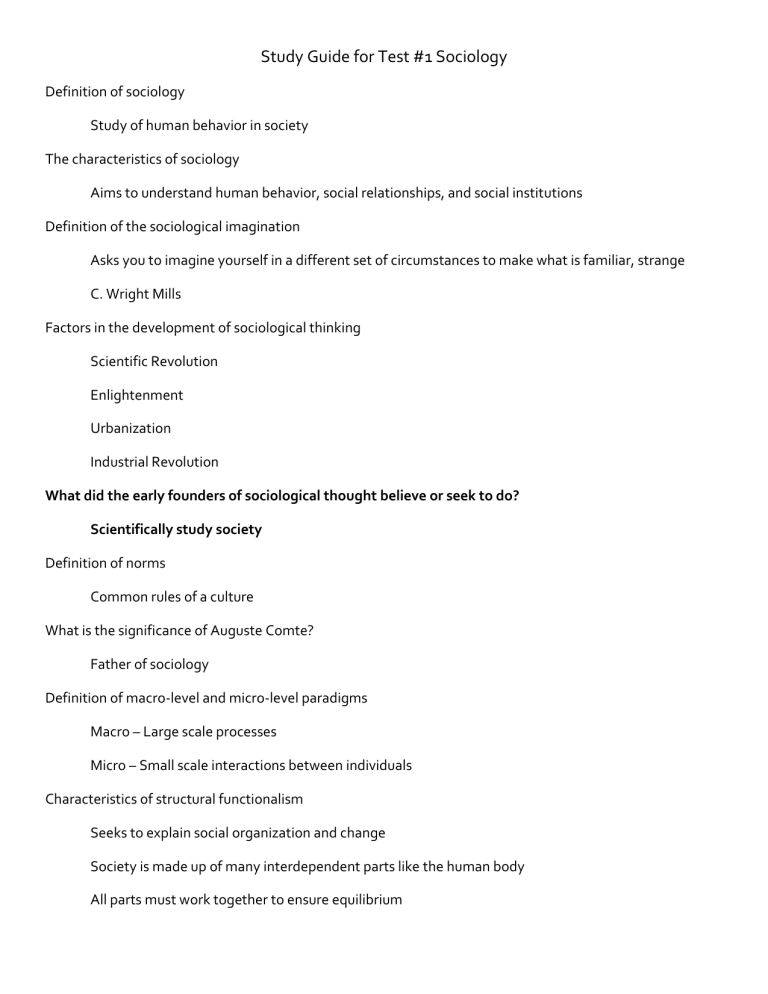
Study Guide for Test #1 Sociology Definition of sociology Study of human behavior in society The characteristics of sociology Aims to understand human behavior, social relationships, and social institutions Definition of the sociological imagination Asks you to imagine yourself in a different set of circumstances to make what is familiar, strange C. Wright Mills Factors in the development of sociological thinking Scientific Revolution Enlightenment Urbanization Industrial Revolution What did the early founders of sociological thought believe or seek to do? Scientifically study society Definition of norms Common rules of a culture What is the significance of Auguste Comte? Father of sociology Definition of macro-level and micro-level paradigms Macro – Large scale processes Micro – Small scale interactions between individuals Characteristics of structural functionalism Seeks to explain social organization and change Society is made up of many interdependent parts like the human body All parts must work together to ensure equilibrium Characteristics of conflict theory Says inequalities and injustice are the source of conflicts Resources and power are distributed unequally People with more resources use those resources to keep those with fewer resources in their place Characteristics of symbolic interactionism People created shared meanings regarding symbols and events and then interact on the basis of those meanings Difference between qualitative and quantitative research Qualitative – deals with data that can’t be easily counted, usually by interview Quantitative – Deals with data that can be easily counted and focuses on large scale data gathering, usually done by survey Characteristics of good scientific theories Plan research study Design research plan and method for collecting data Make sense of the data Definition of variable Concept that can take on two or more variables Definition of correlation Degree to which variables are correlated Positive vs. negative correlation Positive Correlation UP, UP or Down, Down Both variables go in the same direction Negative Correlation UP, Down or Down, UP Both variables go in opposite directions Difference between validity and reliability Validity – Accuracy Reliability - Consistency How can bias be introduced into a study? Deductive vs. inductive reasoning Inductive Reasoning Information – pattern – hypothesis – theory Deductive Reasoning Theory – hypothesis – observation – confirmation Definition of sample and population Sample – portion of a large population Population – the whole group to be studied What is the Nuremberg Code and why is it important? Ethical guidelines for human experimentation Developed after WWII Sapir-Whorf hypothesis The structure of a language affects the ways in which its respective speakers conceptualize their world, i.e. their world view Definition of culture Composition of the beliefs, norms, behaviors and products common to the members of a group Nonmaterial vs. material culture Nonmaterial – abstract creations of human culture such as emotions, ideas Material – physical objects created, embraced or consumed by society Definition of beliefs Ideas that people accept as true Distinguish between mores, folkways, and taboos Folkways – fairly weak norms that mark the distinction between rude and polite behavior Mores – strongly held norm, violation seriously offends the standards of acceptable behavior Taboos – powerful mores, violation is considered unthinkable What are the characteristics of laws? Formalized and institutionalized societal norms Usually created to gain something from those violating the norm Definition of ethnocentrism Other cultures are measured against our own where “our own” is considered normal Definition of multiculturalism Being apart of several distinguishable cultures Definition of socialization Lifelong process by which people learn the culture of their society Constructs a sense of who you are, how to think, and how to act Primary way of reproducing culture Definition of the looking-glass self The self-image that results from our interpretation of other people looking at us Interact with someone – they react – you adjust your reaction based off their reaction George Herbert Mead’s explanation of the self Consists of the “I” and “Me” I – impulsive, creative part of a person Me – part of self through which we see ourselves as others see us, wants to conform to norms Definition of significant others Romantic or sexual relationship with another person Definition of generalized other Composite of societal expectations Agents of socialization (examples) Family School Peers Religion Definition of hidden curriculum Unspoken classroom socialization norms Definition of total institutions Setting in which people are isolated from the rest of society for a set period of time and are subject to tight control Primary vs. secondary vs. reference groups Primary – family, close friends Secondary – everything else Differences between working class parents and middle-class parents Working class – obedience and respect for authority Middle class – creativity and spontaneity Five key questions of media literacy (from lecture – this is NOT IN YOUR BOOK) Who created it? What is used to attract my attention? How might different people understand this message differently? What lifestyle, values and points of view are represented in or omitted from this message? Why is the message being sent? Creative techniques used to get your attention (from lecture – NOT IN YOUR BOOK) Set Props Clothing
